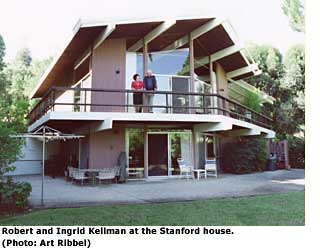The 'Life' House - Page 3
Eichler, too, recognized their marketability, and though he himself did not customarily build split-level designs—preferring to stick to his usual single-story houses geared to a flat site—he did ask Belluschi if he might be interested in designing a single-level house "more typical of our operation" which he could mass produce. But by this time, in late 1958, after the Belluschi-Eichler house was published in 'Life,' Belluschi was on to bigger things. The massive, highly controversial $100-million Grand Central City tower, the largest commercial office building in the world at the time—to be built over Grand Central Station, in the heart of New York City—which he had been asked to design in collaboration with Walter Gropius, pioneering founder of the Bauhaus and former head of Architecture at Harvard, was just beginning to take shape.
Soon to be rechristened the Pan Am Building, this tower was a much ballyhooed, but ill-fated project that was to bring Belluschi much remorse, anguish that was mitigated by the steady stream of appreciative letters from admirers all over the world seeking plans for his understated, but beautifully designed and reasonably priced house in San Mateo's Highlands. For his design in collaboration with Eichler Homes indeed was one that touched the hearts of many at the time.
Second Coming of the 'Life' House
From the pages of the Eichler Network newsletter
By Marty Arbunich
His design of the 'Life' house well in hand, architect Pietro Belluschi beamed in early 1958, "I must say without vanity that I am quite pleased." By the time the rest of the world had a chance to chime in with praise following 'Life' Magazine's exposé later that year, Belluschi had retired his drawings of the San Mateo house, politely turning away a long and steady stream of inquiries requesting plans to turn the 'Life' house design into dream homes for themselves.
"The house which you inquired about was designed for a specific client, and the plans are not for sale," he and his secretary would routinely reply to inquirers over the next decade. When Belluschi finally broke down and, with the assistance of architect A. Quincy Jones, succumbed to what he termed a "special plea" from a lucky but soon-to-be-ungrateful Iowa man in 1963, the Midwesterner would unwisely send back the set of 'Life' house plans with Jones's unpaid $500 invoice, complaining, "These plans are much too expensive for me. I'm afraid the whole house is too expensive for me."
With forces like this at work, and in spite of the flood of interest from among Life's 32 million readers, one would not expect the 'Life' house to have spawned others in its image and likeness. But Eichler owner and Stanford law professor John McDonough, who, since 1951, had lived with his family in Palo Alto's Charleston Meadows development, took a different tack when the 'Life' spread caught his eye in October 1958. He simply knocked on Eichler Homes' door. "When the San Mateo house was built and put up for public view, we went up and saw it," recalled McDonough, now 82 and living in Cupertino. "And we fell in love with that house. So, we went to Joe Eichler--"
 Already quite familiar, and impressed, with Eichler and his houses, it was easy for the McDonoughs to slip comfortably into a second Eichler home, even one as unusual as the 'Life' house. "We started with a favorable impression of Eichler," said McDonough. "When we were shopping for our first house, back in 1951, the Eichlers were startlingly different from any of the others we saw. And Eichler's company was the only builder in the area tied into the G.I. loan. We weren't all that struck by the house at first, but as we began to live there, we came to favor it very much."
Already quite familiar, and impressed, with Eichler and his houses, it was easy for the McDonoughs to slip comfortably into a second Eichler home, even one as unusual as the 'Life' house. "We started with a favorable impression of Eichler," said McDonough. "When we were shopping for our first house, back in 1951, the Eichlers were startlingly different from any of the others we saw. And Eichler's company was the only builder in the area tied into the G.I. loan. We weren't all that struck by the house at first, but as we began to live there, we came to favor it very much."
And by 1958, the McDonoughs were looking for additional living space, beyond their 1,400-square-foot Eichler starter. At the same time, Stanford University decided to open up a large tract of university land, making it available for lease by way of a lottery system to select faculty members for building personal housing. McDonough found himself on the winning side of the lottery, and even man-aged to secure a lot on a slope. "Back then, you could lease the property for 80 years, and build your own house with no particular guidelines or restrictions as to style," McDonough remembered.
With his hillside lot secured, McDonough found the 'Life' house's multi-level orientation even more appealing. When he approached Eichler in late 1958, the builder didn't resist McDonough's proposal. "Eichler had done it once, he could do it again, and now he could even have a show place on the campus." McDonough pointed out.




